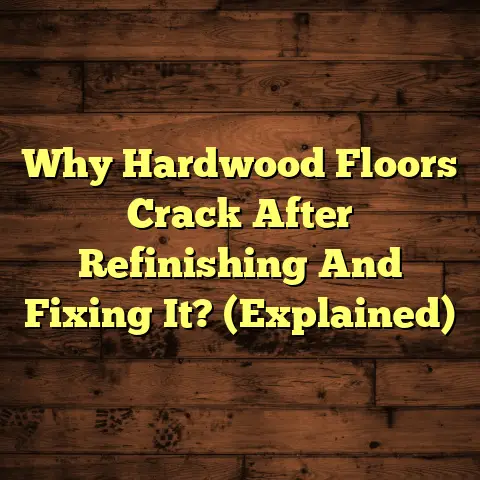Cement Board Under Tile? (9 Install Fails!)
Ever wondered what lies beneath that beautiful tile floor in your bathroom or kitchen?
It’s not just the subfloor – there’s usually another layer doing some serious heavy lifting: cement board.
But here’s the thing: even the best materials can fail if they’re not installed right.
And let me tell you, I’ve seen some cement board installations that make me cringe.
As a flooring contractor with years of experience, I’ve seen it all.
So, let’s dive into the world of cement board and uncover the nine most common installation fails I’ve encountered.
Trust me, knowing these pitfalls can save you a ton of headaches (and money!) down the road.
Layering in Flooring Systems
Think of your tiled floor as a carefully constructed sandwich.
Each layer plays a vital role in the overall strength, stability, and longevity of the finished product.
From the bottom up, we’re typically talking about:
- The subfloor (usually plywood or OSB).
- A layer of thin-set mortar.
- The cement board itself (also called backer board).
- Another layer of thin-set mortar.
- Finally, your beautiful tile and grout.
Why all these layers?
Well, the subfloor provides the foundation, but it’s often not stable or moisture-resistant enough for tile, especially in wet areas like bathrooms.
That’s where cement board comes in.
It’s designed to create a solid, waterproof base that tile can adhere to without cracking or becoming loose over time.
But, and this is a big but, if any of these layers are compromised, the whole system can fail.
And trust me, you don’t want to be re-tiling your bathroom floor anytime soon.
Section 1: Overview of Cement Board
So, what exactly is cement board?
It’s a composite material made of cement, reinforced with fibers (usually fiberglass).
Think of it as a super-durable, water-resistant alternative to drywall in areas that are prone to moisture.
Purpose in Tile Installations:
Its primary purpose is to provide a stable, flat, and water-resistant substrate for tile.
It prevents moisture from seeping into the subfloor, which can cause mold, rot, and structural damage.
Types of Cement Boards Available:
There are several brands and types of cement board on the market, each with its own characteristics.
Some popular options include:
- Durock: One of the most well-known and widely used brands.
- HardieBacker: Another popular choice, known for its durability.
- WonderBoard: A lightweight option that’s easy to work with.
While they vary slightly in composition and weight, they all serve the same basic function.
Benefits Compared to Other Materials:
Why use cement board instead of, say, plywood or drywall?
Here’s a quick rundown of the advantages:
As you can see, cement board offers superior performance in terms of water resistance, stability, and mold resistance – all crucial factors for a long-lasting tile installation.
Section 2: Common Installation Mistakes
Alright, let’s get to the meat of the matter: the installation fails that can turn your dream bathroom into a nightmare.
I’ve seen these mistakes time and time again, and they always lead to problems down the road.
So, pay close attention, and make sure you avoid these common pitfalls.
-
Inadequate Fastening:
This is probably the most common mistake I see.
People either don’t use enough screws, or they
don’t space them properly.The result?
The cement board can move and flex, which leads
to cracked tiles and grout.How to do it right:
Use the correct type of screws (usually cement
board screws) and space them according to the
manufacturer’s instructions.Generally, you’ll want to place screws every
6-8 inches along the edges and every 8-12 inches
in the field of the board.Don’t skimp on the screws – it’s a small investment
that can save you big headaches later. -
Not Using Thin-Set Mortar:
This one blows my mind, but I’ve seen it happen.
Some people think they can just screw the cement
board directly to the subfloor without using
thin-set mortar.Big mistake!
The thin-set mortar fills any gaps between the
subfloor and the cement board, creating a solid,
unyielding base.Without it, you’re relying solely on the screws to
hold everything together, which is not enough.How to do it right:
Apply a generous layer of thin-set mortar to the
subfloor before placing the cement board.Use a notched trowel to create ridges in the mortar,
which will help it bond to both surfaces.Then, screw the cement board in place while the
mortar is still wet.This creates a strong, permanent bond that will
prevent movement and cracking. -
Poor Joint Treatment:
The joints between cement board panels are weak
spots in the installation.If they’re not treated properly, they can become
a source of cracks and leaks.How to do it right:
After the cement board is installed, cover the
joints with fiberglass mesh tape.Then, apply a layer of thin-set mortar over the tape,
feathering it out to create a smooth, seamless
transition.Make sure the thin-set mortar is fully cured before
you start tiling.Some people use self-adhesive mesh tape.
While it can work in some situations, I prefer
the non-adhesive type embedded in thin-set, as
it creates a stronger, more durable bond. -
Improper Cutting Techniques:
Cement board can be tough to cut, and using the
wrong tools or techniques can lead to problems.For example, trying to cut it with a utility knife
is a recipe for disaster.It’s not only difficult, but it can also create
a lot of dust, which is not good for your lungs.How to do it right:
Use a scoring knife or a specialized cement board
cutter to score the board along the cut line.Then, snap the board along the score.
For more complex cuts, use a power saw with a
diamond blade designed for cutting cement board.Always wear a dust mask and eye protection when
cutting cement board. -
Neglecting Moisture Barriers:
In wet areas like showers and tub surrounds,
a moisture barrier is essential to protect the
subfloor from water damage.Some people skip this step, thinking that the
cement board is enough to keep the water out.But that’s not the case.
Water can still seep through the joints and around
the edges of the cement board, eventually causing
mold, rot, and structural damage.How to do it right:
Install a waterproof membrane behind the cement
board before you start tiling.There are several types of moisture barriers
available, including liquid-applied membranes,
sheet membranes, and vapor barriers.Choose the one that’s best suited for your project
and follow the manufacturer’s instructions carefully.Pay special attention to sealing the seams and
penetrations (like showerheads and faucets) to
prevent water from getting behind the membrane. -
Incorrect Board Placement:
The way you lay out the cement board can have
a big impact on the final result.For example, if you align the seams of the cement
board with the seams of the tile, you’re creating
a weak spot that’s prone to cracking.How to do it right:
Stagger the seams of the cement board so they
don’t line up with the seams of the tile.This will distribute the stress more evenly and
prevent cracks from forming.Also, make sure the cement board is properly
supported underneath.If the subfloor is uneven or has gaps, the cement
board can flex and crack. -
Ignoring Floor Flatness:
Tile needs a flat, level surface to adhere to properly.
If the subfloor is uneven, the tile can crack,
become loose, or develop lippage (uneven edges).How to do it right:
Before you install the cement board, check the
flatness of the subfloor with a level or a straightedge.If there are any dips or bumps, fill them in with
a self-leveling compound or a patching compound.Make sure the compound is fully cured before you
start installing the cement board. -
Failure to Allow for Expansion:
Like any material, cement board and tile expand
and contract with changes in temperature and humidity.How to do it right:
Leave a small gap (about 1/4 inch) around the
perimeter of the installation and at transitions
(like doorways).Fill the gap with a flexible sealant, like caulk,
to allow for movement.Also, consider using expansion joints in large
tile installations to accommodate movement. -
Using the Wrong Type of Tile:
Not all tiles are created equal.
Some tiles are more prone to cracking or
delamination than others.And some tiles are not compatible with cement
board installations.For example, very large format tiles (think 24×48
inches or larger) require a perfectly flat and
stable substrate.If the cement board installation is not up to
par, these tiles can easily crack.How to do it right:
Choose a tile that’s appropriate for the application
and the substrate.If you’re using large format tiles, make sure the
cement board installation is flawless.Consult with a tile professional to get recommendations
on the best tile for your project.
Section 3: Implications of Installation Fails
So, what happens if you mess up the cement board installation?
Well, the consequences can range from minor annoyances to major disasters.
Here’s a breakdown of the potential implications:
- Cracked Tiles and Grout: This is the most common problem.
When the cement board moves or flexes, it puts
stress on the tile, causing it to crack.
Cracked grout is not only unsightly, but it
can also allow water to seep behind the tile,
leading to further damage. - Loose Tiles: If the cement board is not properly
bonded to the subfloor, the tiles can become loose
and wobbly.
This is a safety hazard, as loose tiles can trip
people or cause them to fall. - Water Damage: If water gets behind the tile, it
can cause mold, rot, and structural damage to the
subfloor and surrounding walls.
This can be a very expensive problem to fix. - Costly Repairs: Fixing a botched cement board
installation can be a major undertaking.
You may have to remove the tile, replace the
cement board, and re-tile the entire area.
This can cost hundreds or even thousands of dollars. - Time Delays: A bad cement board installation can
delay your project by days or even weeks.
This can be frustrating and inconvenient, especially
if you’re living in the middle of a renovation. - Dissatisfaction: Ultimately, a poorly installed
tile floor is just plain disappointing.
You’ll have to live with the imperfections and
the knowledge that the job wasn’t done right.
Section 4: Real-World Case Studies
Alright, let’s get real for a minute.
I want to share some stories from the trenches – real-world examples of these installation fails and the consequences they had.
These aren’t just theoretical problems; they happen all the time.
Case Study 1: The Shower Stall Disaster
I got a call from a homeowner who had just finished re-tiling his shower stall.
He was so proud of his work, but after a few weeks, he noticed cracks appearing in the grout.
I went over to take a look, and it was clear that the cement board had not been properly installed.
He had skipped the thin-set mortar between the cement board and the subfloor, and he had not treated the joints properly.
As a result, the cement board was moving and flexing, causing the grout to crack.
I had to tear out the entire shower stall, replace the cement board, and re-tile the whole thing.
It was a costly and time-consuming repair, but it was necessary to prevent further water damage.
Quote from the homeowner:
“I thought I could save some time and money by
skipping a few steps, but it ended up costing me
way more in the long run.
I wish I had done it right
the first time.”
Case Study 2: The Kitchen Floor Fiasco
Another time, I was called in to fix a kitchen floor that had been installed by another contractor.
The homeowner had complained that the tiles were loose and wobbly.
When I pulled up the tiles, I discovered that the cement board had been installed over an uneven subfloor.
The contractor had not bothered to level the floor before installing the cement board, so the tiles were not properly supported.
I had to remove the cement board, level the subfloor, and install new cement board before re-tiling the floor.
Quote from a fellow contractor:
“I always tell my guys, ‘Take the time to prep the
subfloor properly.
It’s the foundation of the whole
job.’ If you skip that step, you’re setting yourself
up for failure.”
Case Study 3: The Bathroom Leak Nightmare
I once inspected a bathroom where the tile floor had been leaking for months.
The homeowner had tried everything to stop the leak, but nothing seemed to work.
When I pulled up the tile, I found that the moisture barrier behind the cement board had been improperly installed.
There were gaps and tears in the membrane, allowing water to seep through to the subfloor.
The subfloor was completely rotten, and the surrounding walls were starting to show signs of mold.
I had to gut the entire bathroom, replace the subfloor and walls, and install a new moisture barrier before re-tiling the floor.
Quote from a building inspector:
“Moisture is the enemy of any building.
If you don’t
take steps to prevent water from getting into the
structure, you’re asking for trouble.”
Section 5: Conclusion
So, there you have it: the nine most common cement board installation fails I’ve encountered in my career.
I hope this article has been helpful and informative.
Remember, proper installation is key to a long-lasting, beautiful tile floor.
Don’t cut corners, don’t skip steps, and don’t be afraid to ask for help if you’re not sure what you’re doing.
Investing the time and effort to do the job right the first time will save you a lot of headaches (and money!) down the road.
Happy tiling!
Remember, this isn’t just about following rules; it’s about understanding why these steps are important.
When you understand the “why,” you’re more likely to do the job right and avoid costly mistakes.
Good luck with your next tiling project!





